Who wants to be able to swim with your coral?
- Thread starter halmus
- Start date
charleshardy5;308618 said:
Yeah you got it! I was specifically thinking of video games such as a third person with a free floating camera. Usually they have a button you can push no matter what direction your character faces it will center the camera over his shoulder and thus the camera is now oriented "forward"
Meanwhile, another team mate was working on the software to translate the rotational state into which motor(s) should be turned on relative to the direction the camera is facing while on the web. It got a little tricky because the camera feed is upside down from what you'd expect. That means that we had to mount the camera upside down and right becomes left from the perspective of the user.
The web interface is much more easy to use now that this is working. I'll post up video of the system working and some details about how this all was accomplished.
Thanks for the encouragement. We have our big presentation on June 5th. I'm moving out there to Denver mid-June. Then, I'm going to set this up at my house with some fake coral and hearty fish. At that point, I'll post a link to the web-site hosted by this system. You all will be able to swim around it and test it out.
I'm not posting anything before then because we're trying to limit the use of the rotation until after we've shown on the 5th. A major weak point in the system is the custom acrylic gear we fabricated. Last weekend a few of the teeth were shredded off of the gear. I had to dismantle the system, route off the old gear, engineer a new one that is hopefully more robust, mount it, and retest. The teeth are just too fine to use acrylic. However, we don't have access to anything that will machine a custom aluminum gear.
I'm not posting anything before then because we're trying to limit the use of the rotation until after we've shown on the 5th. A major weak point in the system is the custom acrylic gear we fabricated. Last weekend a few of the teeth were shredded off of the gear. I had to dismantle the system, route off the old gear, engineer a new one that is hopefully more robust, mount it, and retest. The teeth are just too fine to use acrylic. However, we don't have access to anything that will machine a custom aluminum gear.
Man that's a huge bummer. Is using aluminum even an option though? I figure its not a component actually touching the water but evaporation over time would condense on the parts then potentially drip back into the system. Maybe something like that is kinda off the wall and tge ammounts woukd be miniscule but still i think it's something to consider. Good luck with your presentation though! Man you Better believe I can't wait to play around with this once you post the link lol.
charleshardy5;310162 said:
Is using aluminum even an option though? I figure its not a component actually touching the water but evaporation over time would condense on the parts then potentially drip back into the system.
You might be an engineer if...You have no life, and you can PROVE it mathematically.
Do you have the ability to 3D print a new gear? I don't have much experience with 3D printers, but this sounds like a possible application for it and I bet you have access to a printer at school. Not sure exactly if the resin teeth are stronger than acrylic, but maybe worth looking into. Just a thought. Good luck!
SkyShark;310192 said:
Do you have the ability to 3D print a new gear? I don't have much experience with 3D printers, but this sounds like a possible application for it and I bet you have access to a printer at school. Not sure exactly if the resin teeth are stronger than acrylic, but maybe worth looking into. Just a thought. Good luck!
We do have access to a 3D printer. I'll have to ask the manager there about the strength of material. From handling some of the print jobs I get the sense that it might not be as strong, but that's a total guess.
I am hopeful that the new acrylic gear will work out better than the last one. The original was drawn in Inkscape (think MS Paint for mechanical drawings) by laying out a circle as the guideline and painstakingly placing and spacing ~240 triangles around it. It was the brute force method to make a 6" dia gear. Turns out the the software has a built-in gear tool. Why work smarter when you can work harder? Maybe I have that phrase back words. The parameters were a little tricky to convert but the end product meshes much better with the existing pinion drive gear. That should alleviate some stress and give it longer life.
halmus;310200 said:
Thanks shark.
We do have access to a 3D printer. I'll have to ask the manager there about the strength of material. From handling some of the print jobs I get the sense that it might not be as strong, but that's a total guess.
I am hopeful that the new acrylic gear will work out better than the last one. The original was drawn in Inkscape (think MS Paint for mechanical drawings) by laying out a circle as the guideline and painstakingly placing and spacing ~240 triangles around it. It was the brute force method to make a 6" dia gear. Turns out the the software has a built-in gear tool. Why work smarter when you can work harder? Maybe I have that phrase back words. The parameters were a little tricky to convert but the end product meshes much better with the existing pinion drive gear. That should alleviate some stress and give it longer life.
We do have access to a 3D printer. I'll have to ask the manager there about the strength of material. From handling some of the print jobs I get the sense that it might not be as strong, but that's a total guess.
I am hopeful that the new acrylic gear will work out better than the last one. The original was drawn in Inkscape (think MS Paint for mechanical drawings) by laying out a circle as the guideline and painstakingly placing and spacing ~240 triangles around it. It was the brute force method to make a 6" dia gear. Turns out the the software has a built-in gear tool. Why work smarter when you can work harder? Maybe I have that phrase back words. The parameters were a little tricky to convert but the end product meshes much better with the existing pinion drive gear. That should alleviate some stress and give it longer life.
3D printers are strong for large pieces, but lack rigidity on smaller things like a gear.
You might want to try an involute gear instead of triangles to minimize the back pressure on the gear. It will be harder to fab, but they actually last.
You might be an engineer if...You have no life, and you can PROVE it mathematically.
You might want to try an involute gear instead of triangles to minimize the back pressure on the gear. It will be harder to fab, but they actually last.
You might be an engineer if...You have no life, and you can PROVE it mathematically.
I had to look up involute gears. I'm in computer engineering so any mechanical experience comes from cumulative years playing with LEGOS as a kid and growing up on a farm/carpentry work. I'm stuck with the pinion gear I already have and the relatively fixed mounting of the drive motor so I have to match the pitch and type of the gear I already have. I can mess with further re-engineering after our presentation. For now, the system is working reliably. I don't want to press my luck. "If it ain't broke..." for the time being.
The only remaining thing is to incorporate the obstacle avoidance. The hardware is all mounted for that now. I'm just waiting for that team member to tweak his code to allow his hardware to communicate with the rest of the system. That should be done soon. The LEDs don't seem to interfere with his sensors too much. They introduce some noise but the level of noise is minimal enough that we can filter it out in the software.
The only remaining thing is to incorporate the obstacle avoidance. The hardware is all mounted for that now. I'm just waiting for that team member to tweak his code to allow his hardware to communicate with the rest of the system. That should be done soon. The LEDs don't seem to interfere with his sensors too much. They introduce some noise but the level of noise is minimal enough that we can filter it out in the software.
Time for more updates:
The web portion of the project is done for now. After testing and getting feedback from you all, we went ahead and added the sensors for the system to keep track of the camera's orientation. With that functionality in place, another team member started working on adjusting the rest of the software to provide the functionality of a 1st person viewpoint while interacting with the web interface.
It's time to get nerdy. The movement of the motors controlling the X and Y axis depends on the context or orientation of the camera. To make this happen, I put together a table that translates which motor should be activated and in what direction based on which of 8 discrete states of camera orientation. The table is based on this basic diagram:
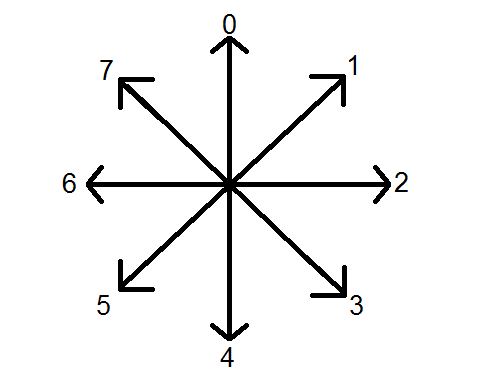
And the table generated from the diagram:
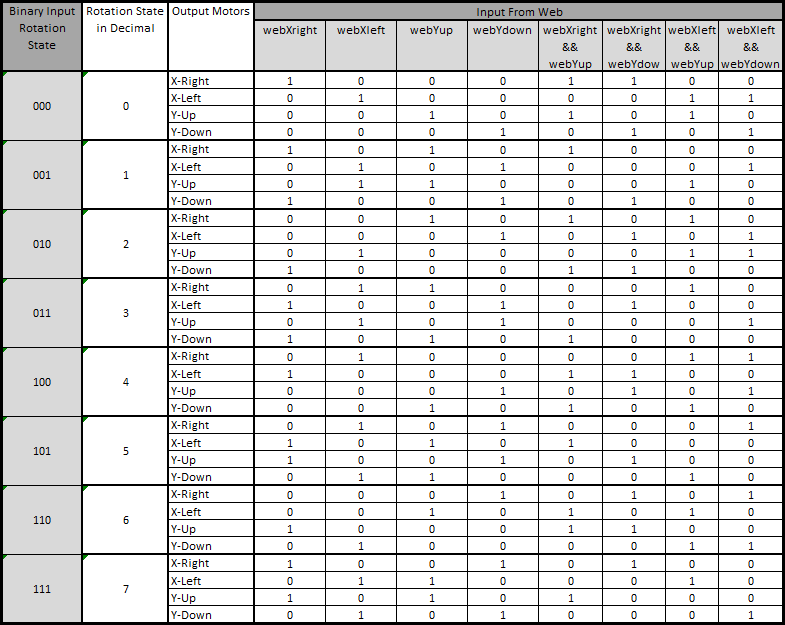
The web portion of the project is done for now. After testing and getting feedback from you all, we went ahead and added the sensors for the system to keep track of the camera's orientation. With that functionality in place, another team member started working on adjusting the rest of the software to provide the functionality of a 1st person viewpoint while interacting with the web interface.
It's time to get nerdy. The movement of the motors controlling the X and Y axis depends on the context or orientation of the camera. To make this happen, I put together a table that translates which motor should be activated and in what direction based on which of 8 discrete states of camera orientation. The table is based on this basic diagram:

And the table generated from the diagram:

I know 1's and 0's don't interest most people on the thread. Here's the revised web interface I put together:
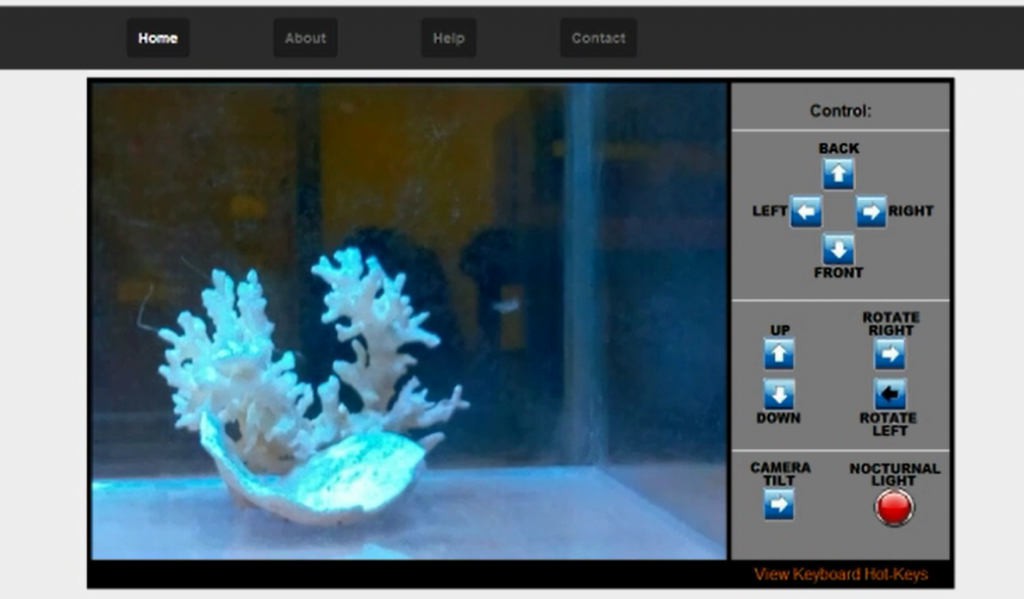
NOTE: This screen capture was taken before I adjusted the text on a few buttons. Now, the buttons display LEFT, RIGHT, FORWARD, and BACK which corresponds with the new 1st person view for the GUI.

NOTE: This screen capture was taken before I adjusted the text on a few buttons. Now, the buttons display LEFT, RIGHT, FORWARD, and BACK which corresponds with the new 1st person view for the GUI.
A "halo" of 8 IR LED's/detector pairs is built into a sealed acrylic housing that will surround the camera housing. The detector circuit is run through an op-amp to filter and amplify the signal received. After testing, we found that the sensor circuit is minimally affected by the most current aquarium lighting technology. Six Rapid LED PAR38 (Mixed Color with UV) bulbs were used in testing. More testing should be conducted to ensure that other common lighting configurations like MH, T-5 HO, and T-8 will also introduce minimal noise into the system. The current sensor array communicates interrupt signals to the rest of the system to indicate an obstacle present in 8 major directions of travel to prevent one or both motors from traversing further in the given direction.
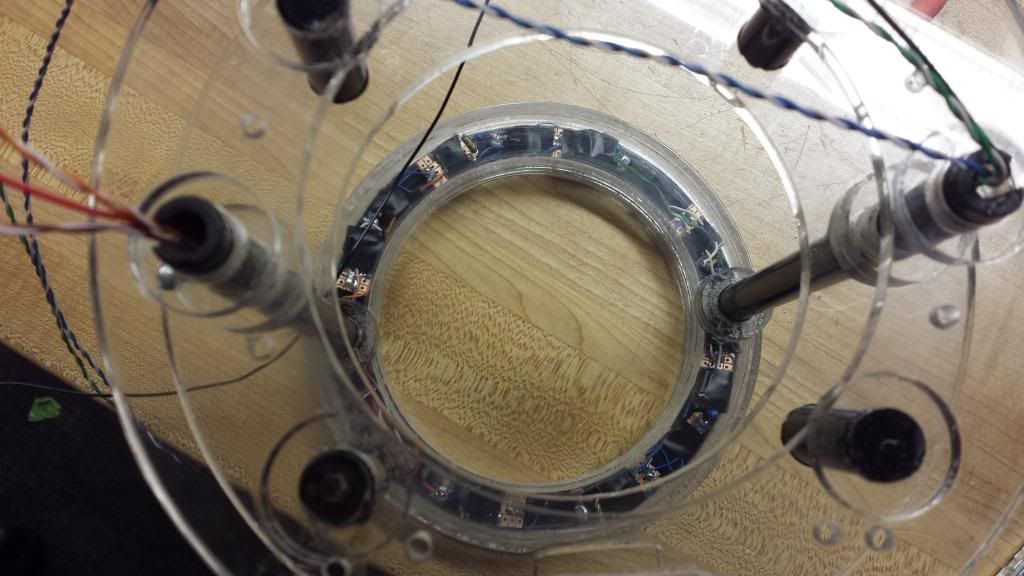

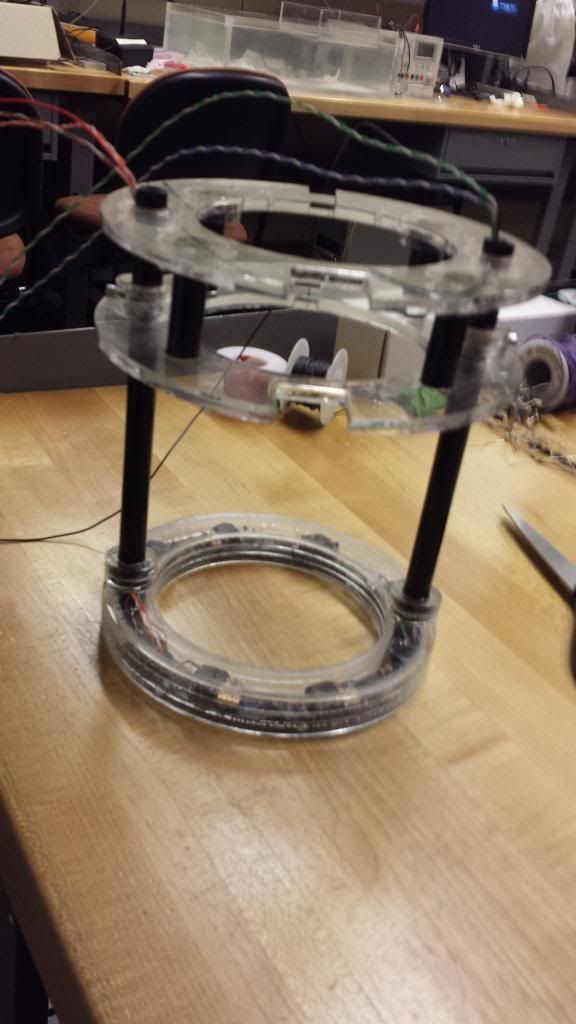
After months of testing and reconfiguring the sensor configuration, the final arrangement was settled on. Once the sensor package was sealing in the final acrylic housing, final tests were run to ensure the system was still operating as designed. Initially, a weighted moving average algorithm was implemented in the software to smooth out the data being recorded from the sensors. Later, a more simple average for each sensor pair was implemented in a loop. Twenty samples are recorded for each sensor pair and the data is then averaged and compared against a hard-coded threshold which is used to fine-tune the response.
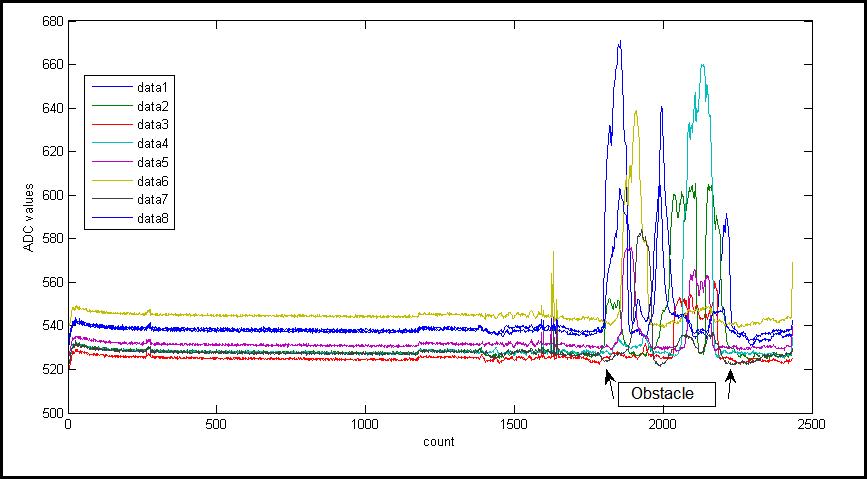



After months of testing and reconfiguring the sensor configuration, the final arrangement was settled on. Once the sensor package was sealing in the final acrylic housing, final tests were run to ensure the system was still operating as designed. Initially, a weighted moving average algorithm was implemented in the software to smooth out the data being recorded from the sensors. Later, a more simple average for each sensor pair was implemented in a loop. Twenty samples are recorded for each sensor pair and the data is then averaged and compared against a hard-coded threshold which is used to fine-tune the response.

The final step to complete the design was to add an additional initialization phase. When the system is first turned on or reset, the camera housing rotates back to its furthest limit while the housing is lifted out of the water. Rotating back to one of the limits ensures that the system initializes the rotational state to the same orientation every time. Lifting the camera out of the water ensures that all obstacles are avoided as the system resets to the origin. The next step moves the camera housing back to the origin so that it is out of the way for tank maintenance. The final step rotates the camera back to the optimal viewing position looking across the aquarium while the camera housing is lowered back down into the water.
This video is a long one we put together that will be displayed at our booth during the presentation of our project at UWT. Much of the content was taken from smaller videos and images already shared here, but it shows how the project was developed from concept to design to a final product.
[video=youtube;dlC-qmXwbCM]https://www.youtube.com/watch?v=dlC-qmXwbCM[/video]
This video is a long one we put together that will be displayed at our booth during the presentation of our project at UWT. Much of the content was taken from smaller videos and images already shared here, but it shows how the project was developed from concept to design to a final product.
[video=youtube;dlC-qmXwbCM]https://www.youtube.com/watch?v=dlC-qmXwbCM[/video]
CRW Reef;312526 said:
Wow this is so very very cool!!!!!!!!!! You guys did a great job with this and the video turned out great!!!! What are the eventual goals or applications you are hoping to suit this awesome technology onto or into?
As we've said from the beginning, we know this whole thing is "over-the-top". It's not all that reasonable as is but it has been fun. I can see two things coming from this.
1. When we showed the initial version at an expo in Feb in Seattle, one of the Utah vendors approached us and told us that we was looking for something very similar to this with fewer bells and whistles. Most of his sales come from his online store. He's looking for a system that will allow his online customers to essentially select a coral from his existing site and through some interface allow them to see a live video stream. Basically, it would be taking WYSIWYG to the next level. So, what we've built could be slimmed down to have only an X and Y axis.
2. I think hobbyists would jump at the opportunity to have a small camera submerged in their tanks. I'm thinking of something fixed in the corner of their tanks out of the way that possibly has pan/tilt capabilities. But, the idea would be to have something affordable and low profile.
Currently, those of us who have attempted to do something like this have relied on existing technology like USB or IP cameras. They can be adapted to fit in the tank also. They might even provide better streaming quality. However, most people I've known that have placed a camera on their tank simply stick it on a wall on one end of their tank and not all of those have pan/tilt capabilities.
I'm actually surprised that Neptune, Reef Keeper, or Reef Angle haven't jumped on this corner of the market yet. Maybe they have.
Oh ya would be very cool for an actual wysiwg frag tank for sure!!!!!!!!!!!!! I was just wondering if you were hoping to take it further to unmanned watercraft or oil platforms and such to aid in repairs and inspections or something. Either way I am def in awe of what you have created and commend you on such a very cool thing for the hobby!!!! :stoked::bravo:
halmus;312533 said:
1. When we showed the initial version at an expo in Feb in Seattle, one of the Utah vendors approached us and told us that we was looking for something very similar to this with fewer bells and whistles. Most of his sales come from his online store. He's looking for a system that will allow his online customers to essentially select a coral from his existing site and through some interface allow them to see a live video stream. Basically, it would be taking WYSIWYG to the next level. So, what we've built could be slimmed down to have only an X and Y axis.
.
.
Great work, so many possibilities!
SynDen
Administrator
Staff member
M.A.S.C Club Member
M.A.S.C. B.O.D.
M.A.S.C President
M.A.S.C Webmaster
